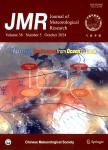Changes in Atmospheric Circulation during the Winter Regional Extreme Cold Events over China since 1960
作者机构:School of Atmospheric SciencesNanjing University of Information Science&TechnologyNanjing 210044 Chinese Academy of Meteorological SciencesChina Meteorological AdministrationBeijing 100081 Jilin Climate CenterChangchun 130062 National Climate CentreChina Meteorological AdministrationBeijing 100081
出 版 物:《Journal of Meteorological Research》 (气象学报(英文版))
年 卷 期:2023年第37卷第5期
页 面:589-603页
核心收录:
学科分类:07[理学] 070601[理学-气象学] 0706[理学-大气科学]
基 金:Supported by the National Natural Science Foundation of China (41790471) Strategic Priority Research Program of Chinese Academy of Sciences (XDA20100304)
主 题:regional extreme cold events interdecadal variation polar vortex blocking high East Asian trough
摘 要:The number of days with occurrence of winter regional extreme cold events(RECEs) in China was found more during 1960/1961–1985/1986(period 1), less during 1986/1987–2005/2006(period 2), but more again during2006/2007–2017/2018(period 3). So far, the differences in the atmospheric circulation favoring RECEs among these three periods are unclear. In this paper, changes in atmospheric circulation during the RECEs over China are examined by using composite analysis based on the station observed temperature data and NCEP–NCAR reanalysis data in winters of 1960/1961–2017/2018. The results show:(1) the stratospheric polar vortex was more active and tended to split before the outbreak of RECEs in period 3 than that in other two periods. The shift of the stratospheric polar vortex to Eurasia helped the upper Arctic cold air to affect the lower latitudes.(2) The troposphere was characterized by a typical or significant three-wave pattern before the outbreak of RECEs in period 2, in contrast to a weakened three-wave pattern in period 1. Compared to periods 1 and 2, the Okhotsk blocking high was stronger in period 3, contributing to the inverted omega-shaped circulation pattern in East Asia–North Pacific section and a shift of global pattern from three-wave to two-wave. The weakened three-wave or two-wave circulation pattern was manifested by the stronger Ural/Okhotsk blocking high, conducive to the strengthening of the meridional circulation and the occurrence of RECEs in East Asia.(3) The Siberian high was the strongest in period 3, followed by period 1, and it was the weakest in period 2. Before the outbreak of RECEs, the Siberian high in period 3 began to intensify one week earlier than that in periods 1 and 2. Thus, the accumulation time of cold air mass in period 3 was the longest. In summary, the synergism of atmospheric circulation at high and low levels in periods 1 and 3 was more conducive to more and strong RECEs than that in period 2. Moreover, the split of the stra



